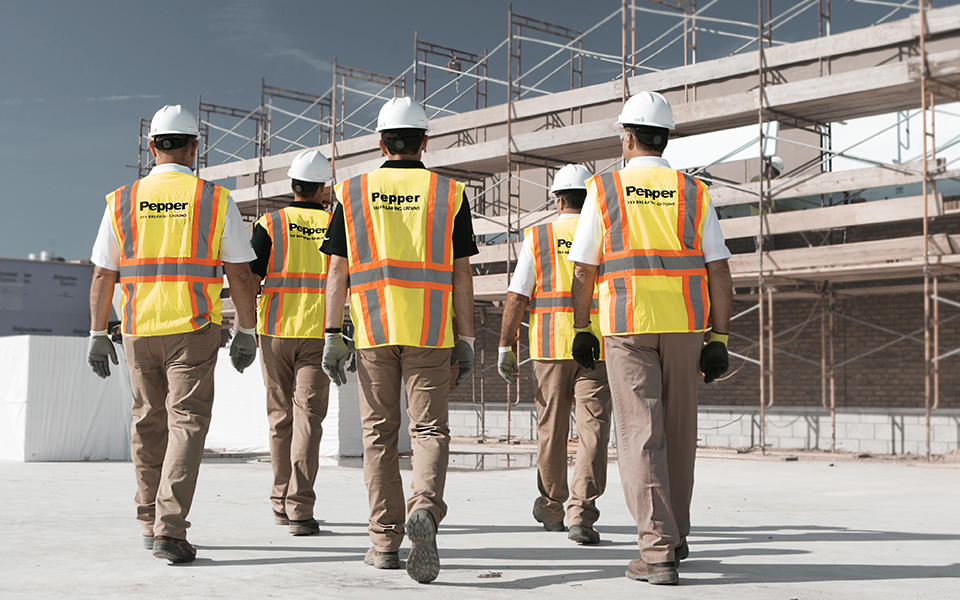Indiana University Health North HospitalQuality, Emerging technology, Workplace
Al Shambery can picture that iconic photo in his head – the one of 11 Empire State Building construction workers perched on a beam, relaxing and eating their lunch high in the New York City sky. No harnesses. No hardhats. Just 69 stories below them.
Al laughs thinking about the image. There's no way he could work in construction if that was the norm by the time he entered the industry. Technology and more extensive standards changed the environment on jobsites long before his first project. But it's still amusing to look back at all the changes since he got his start.
In his 30-year career – 16 of which have been at Pepper – the carpenter foreman has seen countless industry changes.
The son of a carpenter, Al remembers hopping in the car and driving as a family to see buildings his dad helped build. He could hear the pride in his father's voice as he talked about the projects. It sparked an interest, and eventually inspired Al to follow in his footsteps. The love deepened with an apprenticeship, which developed into a career in construction.
Approaches to construction have changed throughout the years, but the commitment to quality by Al and others in the field hasn't. Advancements in technology have improved communication and productivity. And looking back, Al has seen a more skilled workforce enter the field over time.
Evolving communication
Communication is always key on jobsites. One of the most impactful changes to how information is shared has been technology.
"When I first started with Pepper, we just had the two-way phones. Now I have the iPhone, iPad, tablet – all this stuff I carry around," he said. "I've got a mobile office, which is great."
If there are changes to a project, the information no longer has to be relayed over the phone to multiple sources – which often caused confusion and misinformation. Now he can receive updated PDFs instantly; all he has to do is pull it out of his pocket.
That information can go straight to the tradespeople, eliminating the middle man. This minimizes opportunities for miscommunication and allows teams to start working right then and there. It helps build stronger relationships with trades, which ultimately improves quality.
"Everyone knows the expectations. It communicates to everybody on the project what needs to be done, and it helps us collaborate throughout the process."
Increasing productivity
Technology hasn't just affected the types of tools we use, but the projects themselves.
"The buildings are just getting bigger. And everything is more complex because it's a digital world."
Building features are more advanced than they were 30 years ago when a typical structure would only have a couple of phone lines and electrical outlets. Now temperature controls, automatic lights and energy-efficient systems are commonplace.
The tech era gradually arrived, and it was in the early 2000s when Al realized just how high in demand technological luxuries had become – and that they were here to stay. As Pepper built IU Health North Hospital, he wondered how descending screens would be used in the birthing suites.
"Was it for when she had the baby? No, it was for checking emails, playing movies, music, all this stuff. It was pretty elaborate."
Despite the extra features and systems in buildings, production hasn't slowed. In fact, expectations have moved to getting projects done even faster. Thankfully, the tech evolution has helped shift our approach to projects to keep up.
For example, Al says materials used today are often more advanced, but not as difficult to assemble. Items like cabinets used to be built piece-by-piece onsite. Now pre-fabrication has sped up the process for tradespeople. It's like putting together a puzzle.
The teams are also strategic in what tools they utilize. Al remembers the days of having to get screws out of his pouch with one hand and drilling them in with the other. A simple tool like a screw gun can make a tradesperson work more quickly, and it improves quality by providing more accuracy.
"Pepper always has new tools that help with quality. They keep things up to date. If we are out in the field and we say we need something, they'll make the changes and get us the tools or equipment we need to get the job done."
Creating leaders in the field and the industry
Al has noticed a shift. Years ago, if someone's friend needed a job, they'd ask them to come work, even if they'd never been on a construction site before. Now he sees more people going to school for training or working as apprentices before their first jobs.
"You can go into an apprenticeship program right out of high school and quickly get involved in an industry that provides great opportunities to grow professionally."
But there's still much they can learn from Pepper's teams.
Al says watching the superintendents and other leaders has made him a better carpenter.
"They're teachers. They're always there for you and they'll take time to explain stuff to you. Every day there's an opportunity to learn."
Those lessons provide opportunities to grow within the field into leadership positions.
For Al, the leadership sets Pepper apart and makes it family-oriented. It brings him back to the days of tagging along on jobs, learning from his own father. As time has gone on, the desire to pass along that same pride he saw in his dad to his own children has grown.
"Now I drag my kids around and show them projects I worked on. It's come full circle."




